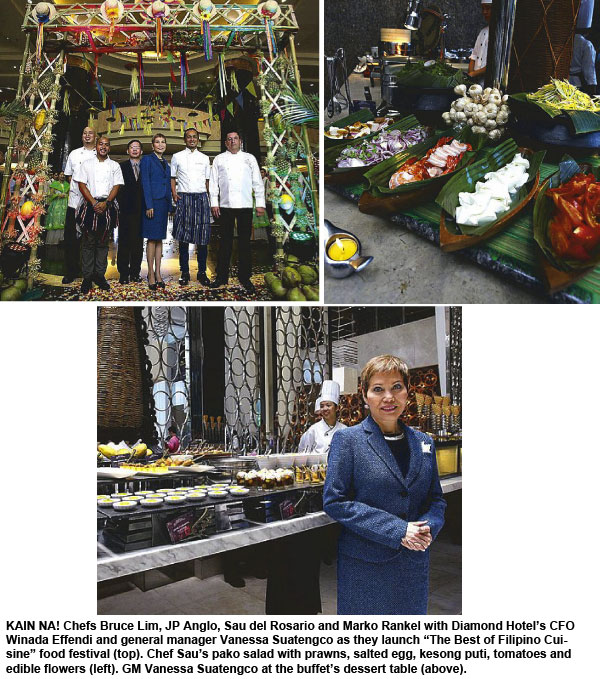It’s more delicious in the Philippines
MANILA, Philippines - We often take for granted our local dishes like adobo, kare-kare and kaldereta as simple lutong bahay, but Diamond Hotel’s annual Filipino Food Festival at the hotel’s Corniche restaurant showcases classic Filipino dishes as interpreted by master chefs, who have added their distinct touches to the all-time favorites.
This year’s “The Best of Filipino Cuisine†food fest, ongoing until May 23, features three of Manila’s celebrity chefs – Sau del Rosario, Bruce Lim and JP Anglo, with the special participation of Diamond’s executive chef Marko Rankel.
Bacolod-born JP Anglo says that Filipino food is indeed a “simple, underestimated cuisine.†But, he adds, that is one of the challenges of cooking it: “Using the simplest ingredients and making them tasty. It might not be the best looking cuisine, but the flavors are very deep.â€
Ilonggo cuisine in particular is the chef’s favorite. “Without a doubt!†he affirms.
“It has a lot of potential,†he adds. “I hope one day it will be recognized. For example, inasal is a world class dish that can go up against other world class chicken dishes. Batchoy, on the other hand, is the Filipino ramen.â€
Chef JP’s Sarsa Kitchen+Bar in Bonifacio Global City aims to elevate these Ilonggo dishes and put them on an international level. “Our cuisine is mahiyain. We need to be more gusty and assertive,†he says.
For the Filipino Food Festival, Chef JP serves up delicious and innovative Ilonggo-based dishes including wagyu salpicao, pritchon pancakes with hoisin sauce, sizzling chicken tinola, Ilonggo lechon baboy, banana wrapped baked salmon with kalabasa gata, lechon angus baka, and more.
“It’s a reflection of my style,†he says of his dishes. “It is 70 to 80 percent Ilonggo because I’m from there, I grew up there, and then there’s 20 to 30 percent of flair or twist because I studied and lived overseas.â€
Chef Sau del Rosario likewise puts his own twist on traditional Filipino dishes. “I do classic dishes with a modern approach,†he says.
Chef Sau describes Filipino food as very diverse, with its Spanish, Japanese, Malay and Chinese influences. “Kare-kare, my signature dish, comes from the Malay and comes from the word curry,†he explains. “Strange enough, it is the curry without curry, instead we use peanuts.â€
Aside from his signature dish, Chef Sau’s offerings at the Filipino Food Festival include Pampanga sisig with foie gras, fried eggs and shallot confit; lamb shank kaldereta, angus beef bulalo; slow cooked tamarind rubbed kambing, and more.
But when asked about his personal favorite, Chef Sau goes back to his kare-kare. “Because it’s my mom’s favorite as well,†he says.
“Whenever I do that it reminds me of my mom, and whenever I cook that for you, I’m taking you to my roots, I’m taking you on a journey.â€
The chef’s version of the dish is made with bagnet and instead of peanuts he has a macadamia truffle sauce. “It’s one way of enhancing and elevating our cuisine,†he says.
“As a French-trained chef, my job is really to incorporate French technique and make the food refined and more global.â€
Chef Sau adds that Filipino cuisine is full of unique flavors. “It is rich and tells a story that goes back to the roots. It is not one dimensional. Ang Pinoy food maraming kwento, maraming history.â€
“Different regions, different taste profiles,†Chef JP agrees, as he points out the special stations at the Filipino Food Festival – his own Ilonggo dishes, Chef Sau’s Kapampangan heritage cuisine with a modern twist, Chef Marko’s German interpretation, and Chef Bruce’s food with a Filipino American influence.
Chef Bruce’s offerings include roasted turkey inasal; adobo sliders with grilled piña slaw on kaiser buns; and Malagos macaroni and cheese with crispy fried bagnet.
At the Filipino Food Festival, the four chefs succeed in bringing out the best in Filipino cuisine and elevating it to modern, exciting, world class dishes.
- Latest
- Trending


















